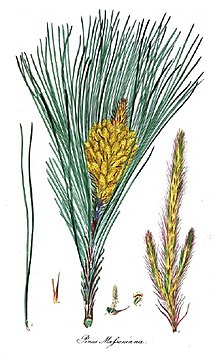Masson's pine
| Masson's pine | |
|---|---|
 |
|
| Scientific classification | |
| Kingdom: | Plantae |
| Division: | Pinophyta |
| Class: | Pinopsida |
| Order: | Pinales |
| Family: | Pinaceae |
| Genus: | Pinus |
| Subgenus: | Pinus |
| Species: | P. massoniana |
| Binomial name | |
|
Pinus massoniana Lamb. |
|
Pinus massoniana (English: Masson's pine, Chinese red pine, horsetail pine; Chinese: 马尾松) is a species of pine, native to Taiwan, and a wide area of central and southern China, including Hong Kong, and northern Vietnam, growing at low to moderate altitudes, mostly below 1,500 m but rarely up to 2,000 m altitude.
It is an evergreen tree reaching 25–45 metres (82–148 ft) in height, with a broad, rounded crown of long branches. The bark is thick, greyish-brown, and scaly plated at the base of the trunk, and orange-red, thin, and flaking higher on the trunk. The leaves are needle-like, dark green, with two per fascicle, 12–20 centimetres (4.7–7.9 in) long and 0.8–1 millimetre (0.031–0.039 in) wide, the persistent fascicle sheath 1.5–2 centimetres (0.59–0.79 in) long. The cones are ovoid, 4–7 centimetres (1.6–2.8 in) long, chestnut-brown, opening when mature in late winter to 4–6 centimetres (1.6–2.4 in) broad. The seeds are winged, 4–6 millimetres (0.16–0.24 in) long with a 10–15 millimetres (0.39–0.59 in) wing. Pollination is in mid spring, with the cones maturing 18–20 months after.
In the 1970s and 80s, the Pinewood nematode from North America and pine-needle scale insect from Taiwan, together virtually eliminated the native Pinus massoniana in Hong Kong.
The species is a common trees in plantation forestry for replacing or compensating of the loss of the natural forest in southern China. Chinese rosin is obtained mainly from the turpentine of this pine (Pinus massoniana) and slash pine (P. elliottii).
...
Wikipedia

